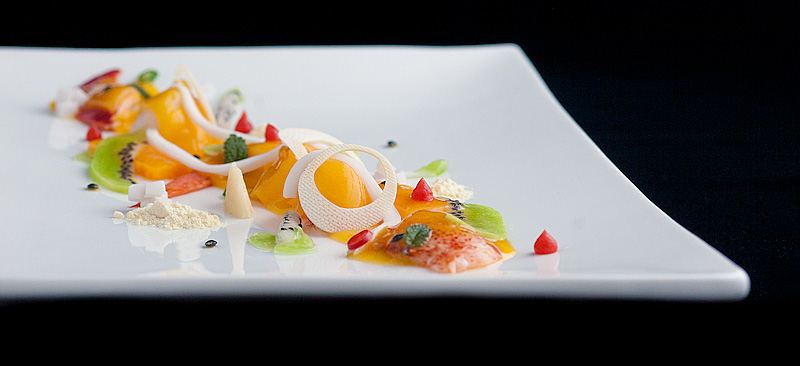
I’ve been eyeing this dish since early December; the photos in the book are eye-poppingly vibrant, and several of the tropical fruits were familiar to me because of time in New Zealand. Appealing too was the bulk of the recipe, which is basically “Acquire exotic fruit, cut into interesting shapes.” As I sifted through the list of ingredients though, it became clearer that this dish represents a small and rare nexus in the cycle of globally-available produce, and getting the stars to align for this moment has taken some patience.
On the plate, we have freshly-cooked lobster meat plated alongside small planks of papaya, ovals of sapote, and rings of heart of palm, all of which have been tossed in a sweet meyer lemon vinaigrette. The bites are topped with a ribbon of passion fruit ‘jam’, then garnished with dots of tamarillo pudding, coconut ribbons and dice, lemon balm leaves, thai chili rings, pineapple powder, kiwifruit slivers, and passion fruit seeds. It tastes like being at the beach, but by that I don’t mean “of dead seaweed and Banana Boat SPF 45”; rather, it’s delightfully tropical, vibrant, buoyant and refreshing, the way you imagine being at the beach is like.
Most of the tropical fruits were straightforward enough to find at Berkeley Bowl; they tend to have kiwi, passionfruit, papaya, and coconut year-round. The hardest to find was tamarillo, followed by sapote. Tamarillo was a familiar one to me in name only; they were easy to find in New Zealand during the inverted autumn/winter months starting in April, and though I never tasted one I can still picture exactly where Moore Wilson’s stocks them in the produce section. They seem pretty difficult to find in the US; they’re grown in several South American countries but no one in the Berkeley Bowl produce dept. (which is mostly comprised of Latin Americans) had ever heard of it.
After a lot of calling around and searching online for tropical fruit distributors, I ultimately used a lifeline: our friend Lesleigh was coming to visit for a few days from New Zealand. I asked her if tamarillos were showing up in markets down there, and if so could she bring me a bag of them when she came? She said they’d just started appearing a few weeks before, and the day before she flew out she went to Moore’s and snagged 10 fresh ones and loaded them carefully into a plastic container to carry on the flight with her. I had to call US Customs to verify she could get them through on her arrival without being fined; Customs calls tamarillos “Tree Tomatoes” (which is what they’re sometimes referred to in South America), so I told her to use that term if they harassed her about it at all. She made it through with only a minor arousal of suspicion and scrutiny by the Customs guards, and once settled at our apartment she brought out the container of my 10 precious tamarillos, which might now be contenders for Most Ridiculous Acquisition so far on this project.
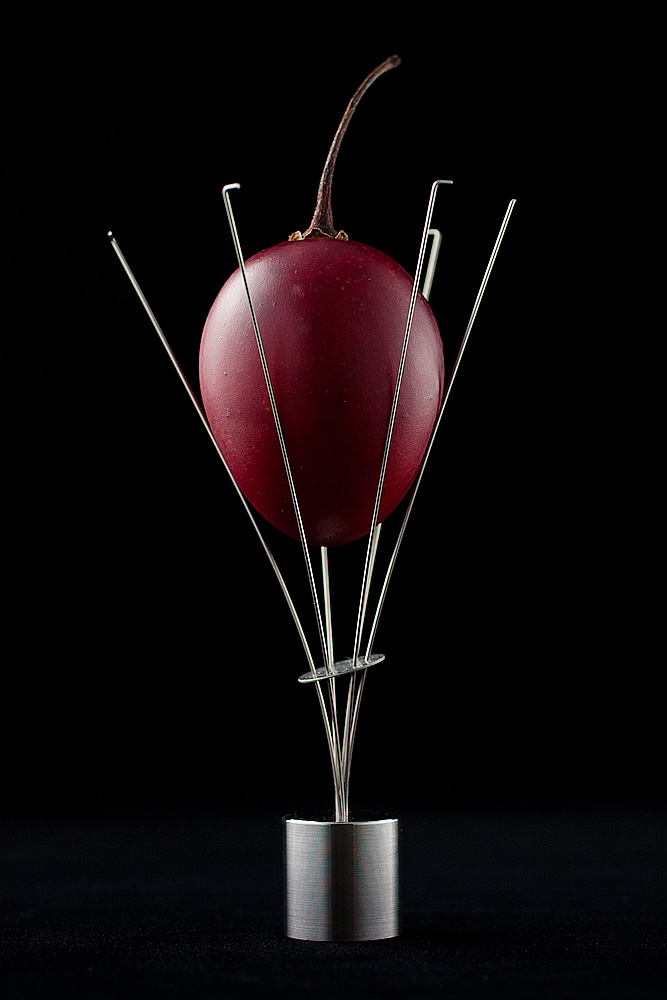
The taste of a tamarillo is very complex; there’s a tart, acetic quality that’s very reminiscent of a cherry or roma tomato, but also layers of ‘tropicaly-ness’, reminiscent of kiwi, passionfruit, or guava. Adding salt pulls forward the tomatoey taste, while sugar brightens up the tropical flavors. It’s pretty neato.
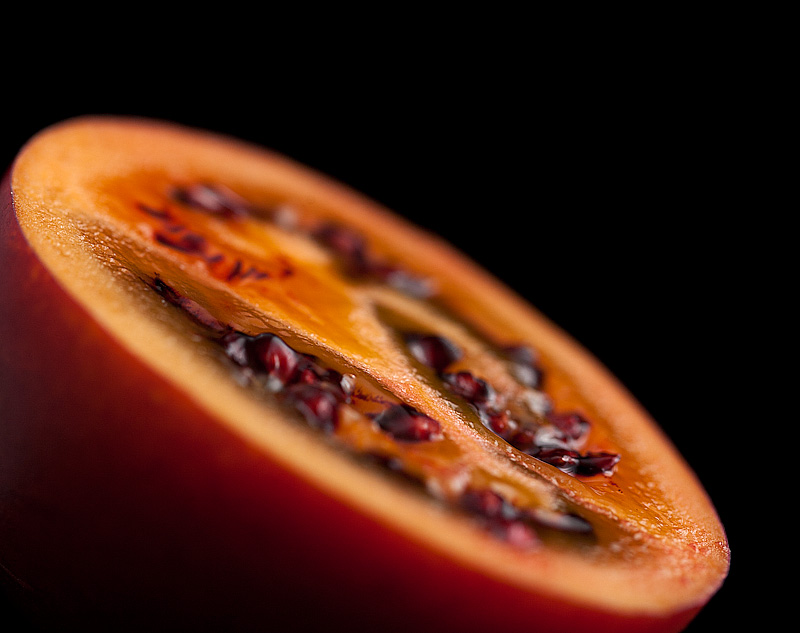
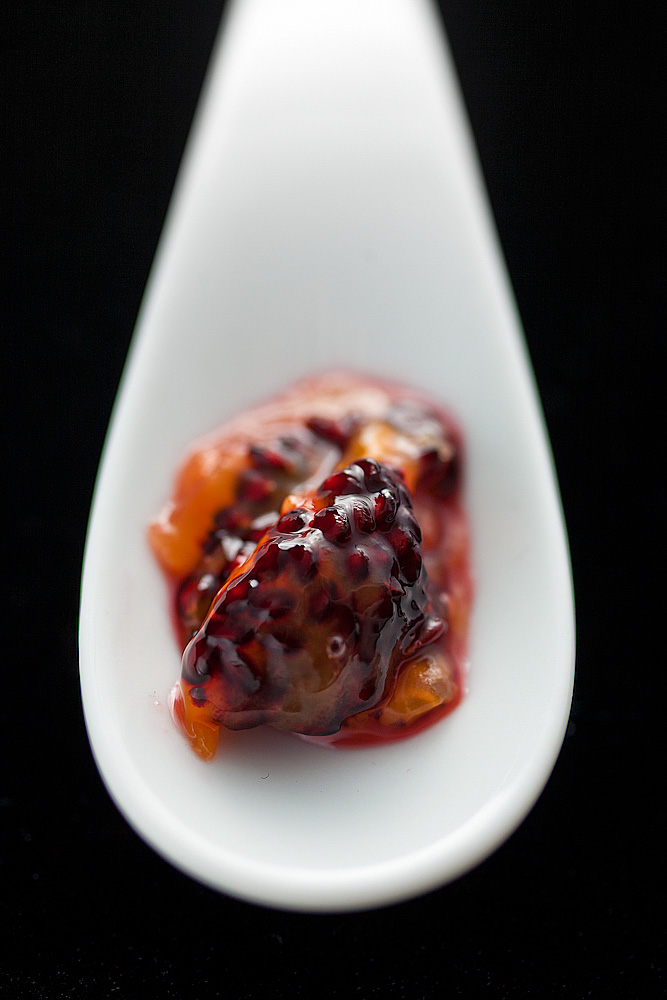
The fruits were surprisingly dense and very firm; they’re quite pretty egg-shaped orbs about the size of a plum, and weigh a little less per fruit than those chrome chinese meditation balls. Lesleigh and Sarah both remarked that there was something very sensual about them, which I thought was peculiar enough of a comment to compel me to try to shoot them as lustfully as one could possibly shoot fruit.
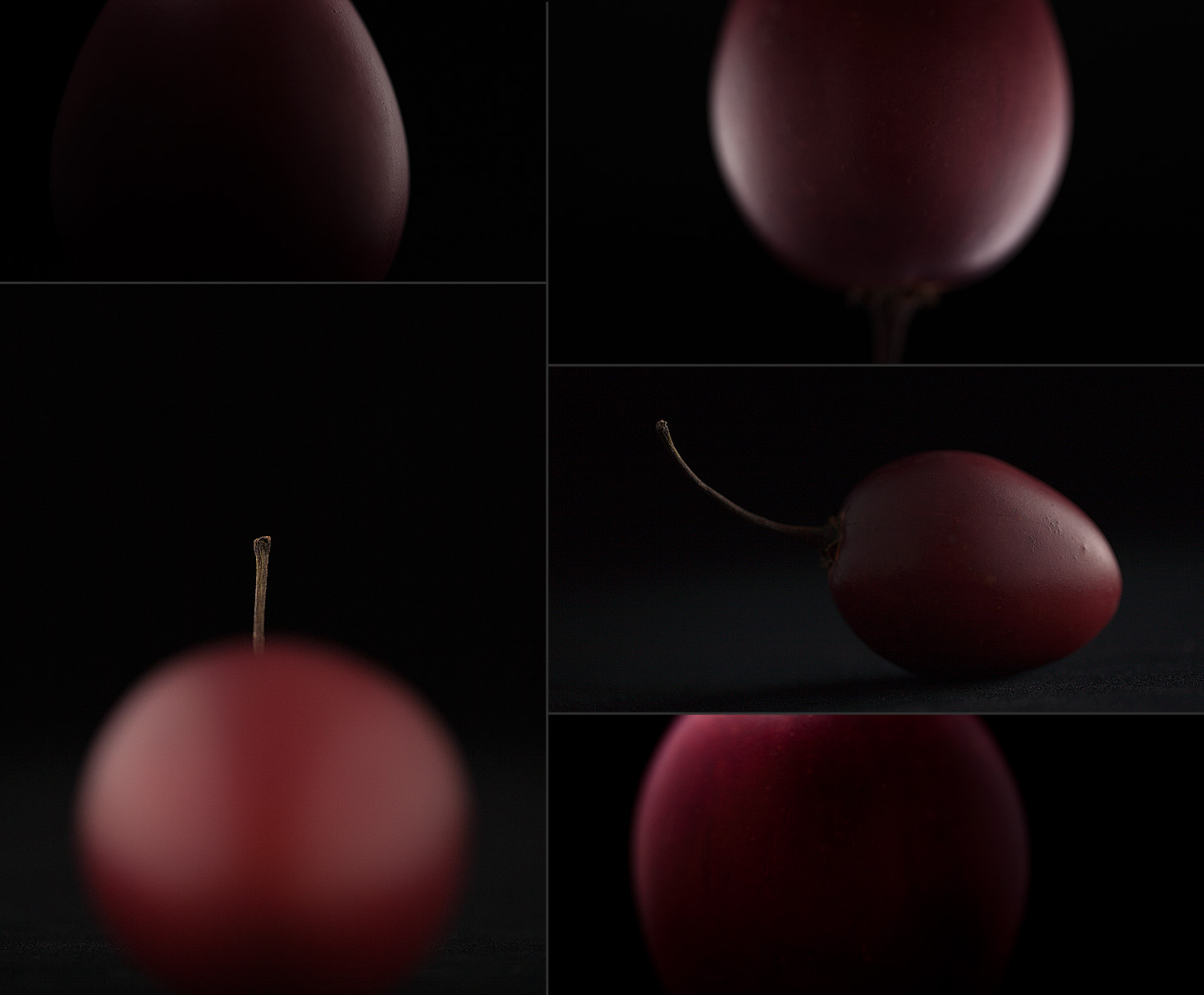
At the same time I was searching for the tamarillos, I also was trying to track down white sapote. The produce guys at Berkeley Bowl recognized ‘sapote’, but had some disagreement as to when they were in season. One said they went out of season in December, another said they come into season in April/May. I wanted to be ready to pounce as soon as I got whiff of them coming in if the latter season was true, so I started going back to Berkeley Bowl every few days to watch more-closely what was drifting in and out of season. Two days before Lesleigh showed up, so did these:
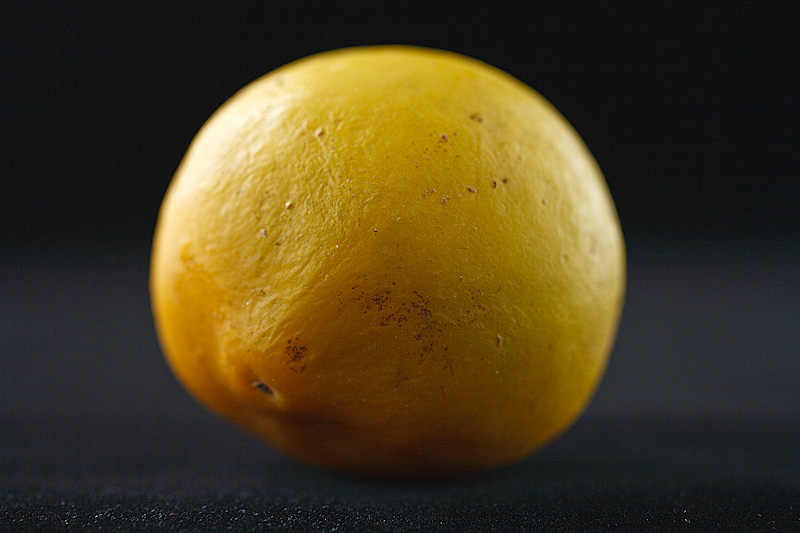
This is a white sapote; it popped up in a small batch very suddenly, and seemed extremely, perfectly ripe. I thought this signified that I’d have at least another few weeks to find them in markets, but I snagged a few right then just to taste them. They were soft, like a very ripe avocado, and the interior flesh was almost custardy in texture. The taste is mild and sweet, sort of like honey and pear.
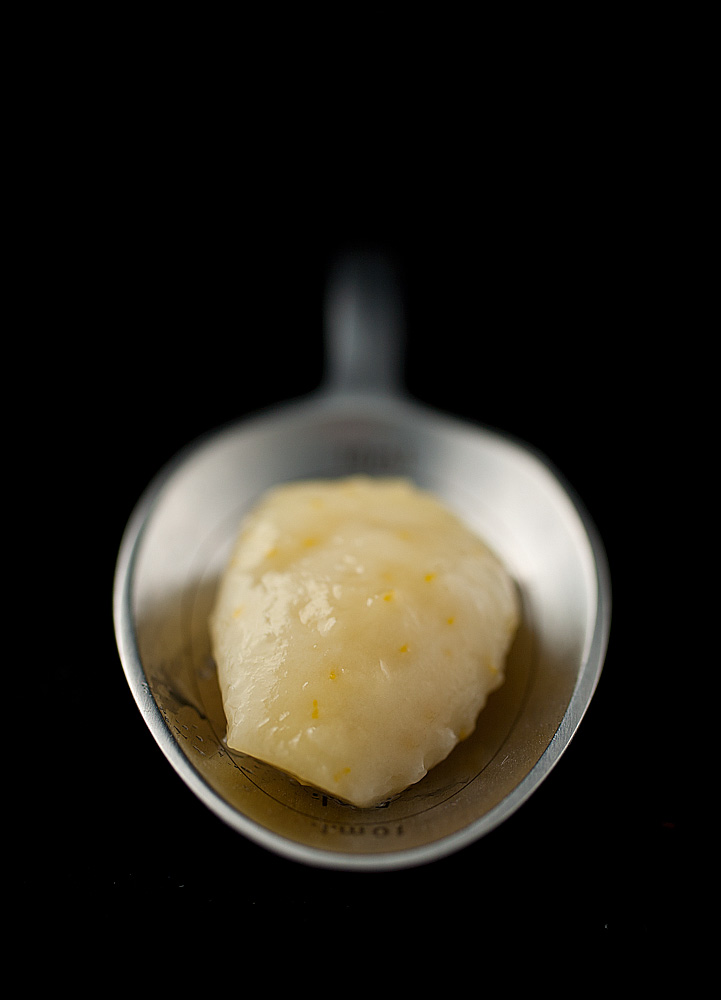
When Lesleigh arrived, I wanted to hang out with her and her kids rather than mess around in the kitchen, so I needed to do something to hold the tamarillos. I read that they freeze well, so I vacuum-sealed them and put them in the freezer. I knew this would make them mushy, but ultimately I was going to puree them in a blender anyway so I didn’t think it would matter much.
After Lesleigh left, I went back to Berkeley Bowl…to find the white sapotes gone. I asked and was told that had been the only batch their supplier had provided, but to keep checking back as they might come back into season. At this point I was feeling a little bummed about this, and also completely perplexed by how Alinea was able to keep this dish on a menu for 3 months in the middle of winter. Tamarillo is a wintertime fruit in New Zealand (summer in the US), and sapote seems to be a springtime fruit; I don’t quite understand how this dish falls into their winter menu.
At any rate, I went back into a holding pattern, checking Berkeley Bowl every few days like some kind of little lost sapote-craving puppy. Finally one friday afternoon I saw a sign in the tropical fruit section for Sapote, and found this:

It’s a Mamey Sapote; a bit bigger than the white sapote, and not quite ripe yet. The recipe specifically calls for white sapote, so I had a few minutes of indecision. Even being fully aware of how ridiculous this internal debate was, there was still a part of me that was all “I’ve waited this long, why not continue being patient so that I can do this totally perfectly?” I decided to take a slightly different tack: I’d tasted the white sapote, which sort of made it less of a white whale in my head, so I got the mamey sapote, and also decided to buy every other tropical fruit that looked nice. I figure this dish really seems to be about capturing a moment of the year when all this produce is at its best, and Alinea certainly wouldn’t not do the dish if one ingredient weren’t available. So I’d take stock of what looked good, and also the opportunity to try as many crazy tropical fruits as I could.
Produce sourced, I had one last thing to take care of: I needed a live female Maine lobster.
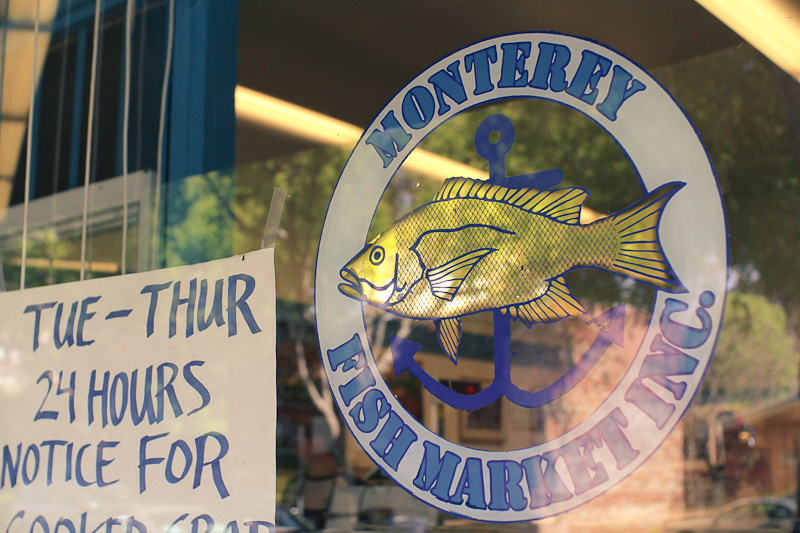
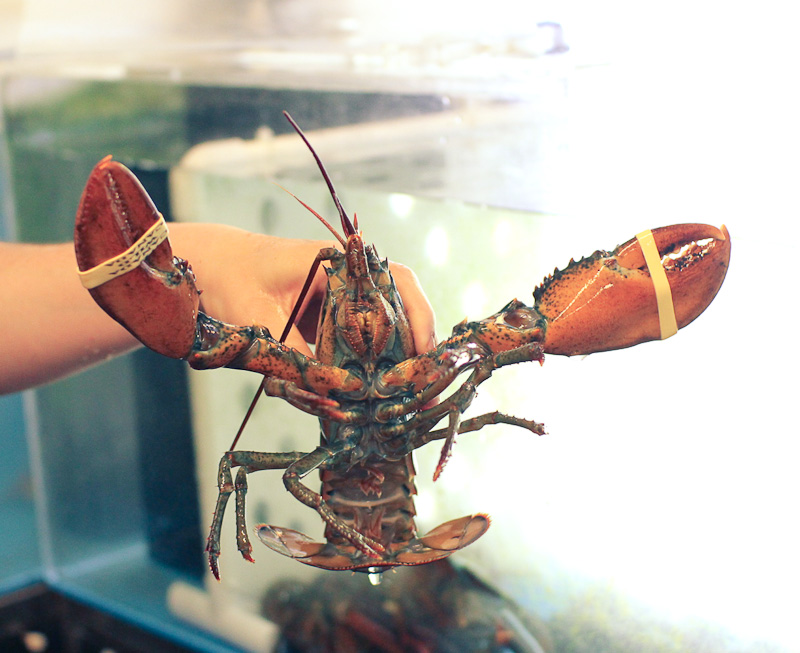
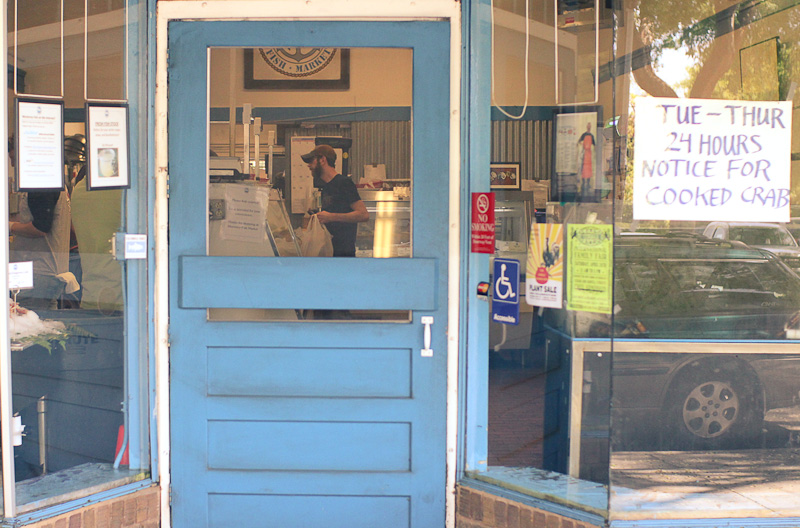
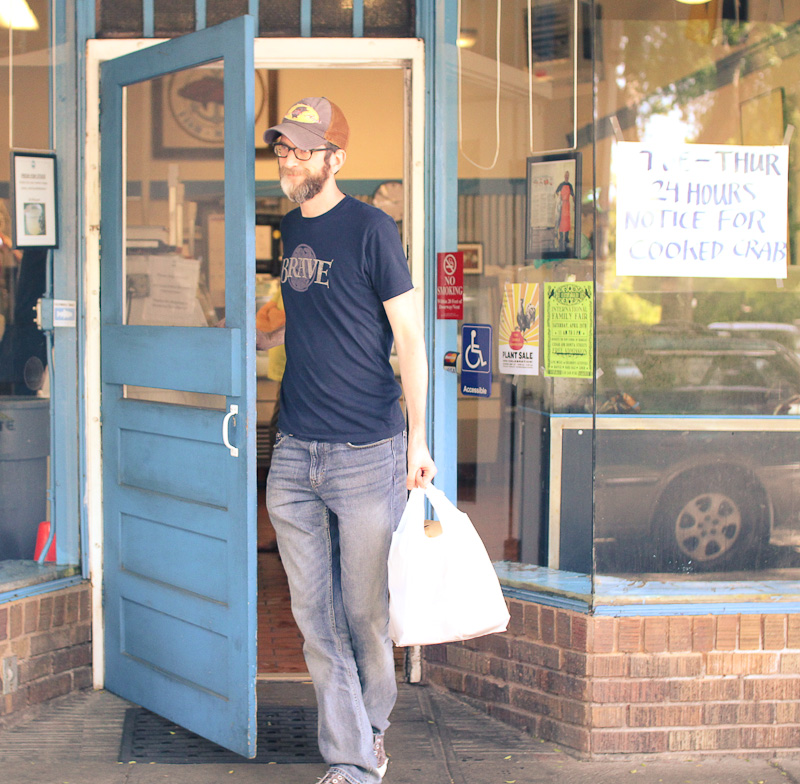
The recipe doesn’t explain why I should be preferring female lobsters, but I asked for one nevertheless. Then it was home to start cooking.
My friend Katie recently recommended a pretty awesome book that was timely to this dish. The book is a collection of essays and memoirs that are wildly compelling. The eponymous essay in the book revolves around the author being hired by a magazine to attend a lobster festival in New England; the first 2/3 or so of the essay is innocuous enough, but Wallace eventually runs right off the rails as he starts wondering aloud about the morality and ethics of killing live lobsters. My friend Jess and I once tried cooking live crab, and Jess felt that the most humane way to kill the crabs was by putting them in cool water and bringing the pot up to temperature slowly, so that it just ‘fell asleep’. Wallace makes note that sea creatures breathe sea water, not tap water, so this attempt at gentle euthanasia in actuality involves drowning the creature slowly. He notes that others have claimed that because lobsters have a decentralized nervous system, they aren’t capable of feeling pain and therefore the thrusting into boiling water isn’t something they can sense. But he points out that surely-obvious are the lobsters’ sudden and obviously desperate movements when this happens, and that we could all probably agree that–at best–the lobster seems suddenly uncomfortable, right? So maybe that shoots the decentralized nervous system theory all to hell? His essay is utterly inconclusive as to what the ‘best’ way to handle this is, and rather than trying to posit a solution, he gets lost in a sea of worry and curiosity as to how people reconcile this to themselves. It’s an amazing essay in that he’s so transparent and honest about the moral conundrum this assignment has thrust upon him, and reading him thrash about is funny, tender, and compelling all at once.
So, this is where my head was at when I got to this point.
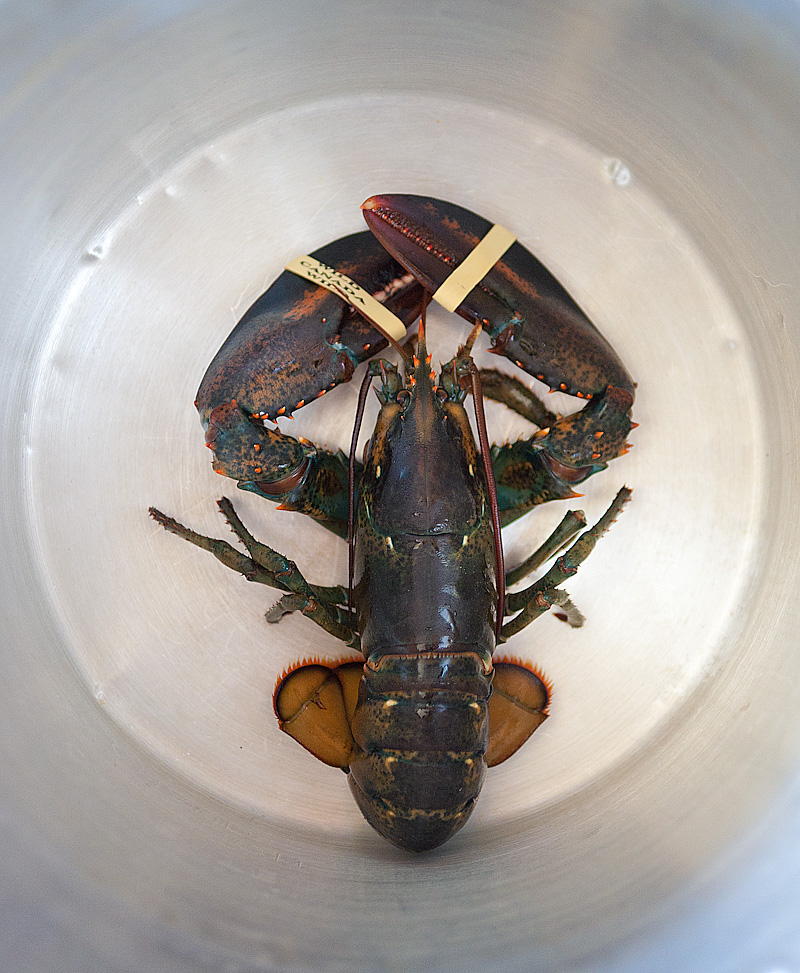
I can’t really sweeten this story up: the recipe instructed me to pour boiling water over the lobster and let it steep for several minutes, and yes, it seemed immediately uncomfortable the moment I did this. Technique and theory get thrown out the window in raw moments like this for me, and instead my head fixes firmly on what I’ve just done. It doesn’t feel very good, but I think that’s a good thing. Like Keller and his rabbits, the experience just makes me want to stay focused and do a really good job with this; I want to earn it.
After the minutes passed, I lifted the lobster out and broke it down.
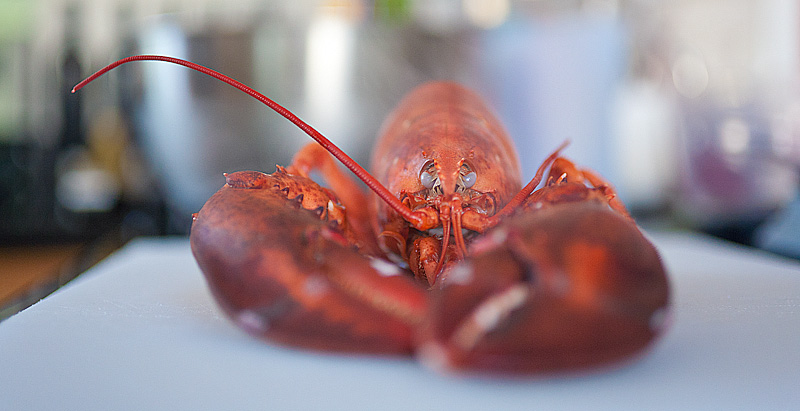
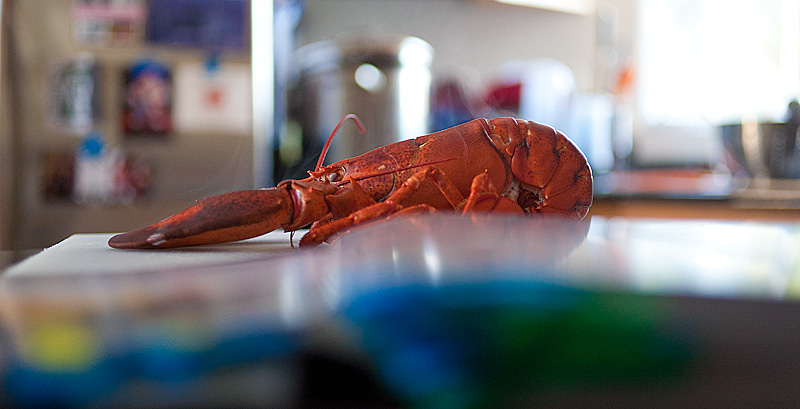
I wanted to keep the natural shape of the meat as intact as possible, which involved some very tedious and careful shell-cracking to get at the claw meats. The meat comes out with some coagulated protein clinging to it, which is totally harmless but not very visually-appealing. So, after separating all the meat, I rinsed them gently in salt water until the white stuff was gone, then held them in the refrigerator while I continued working through the rest of the recipe.
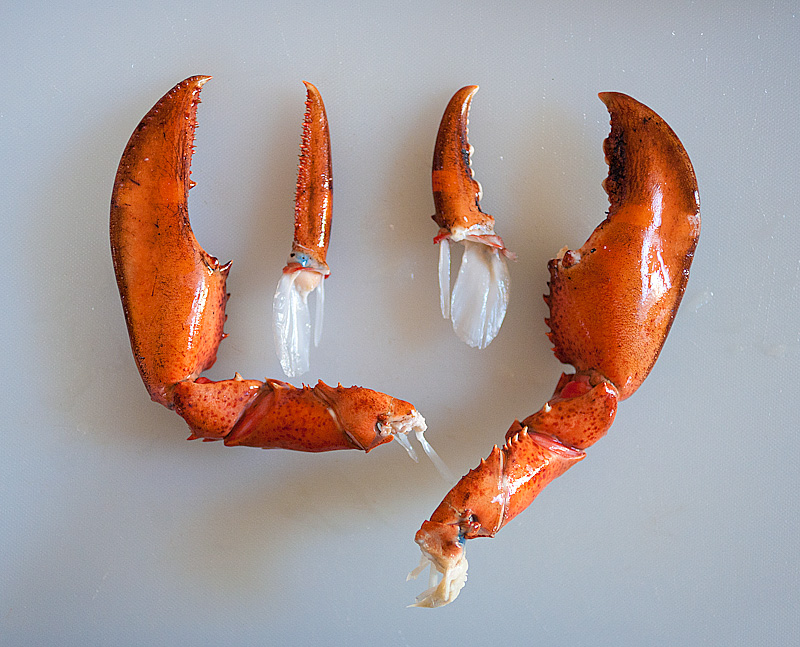
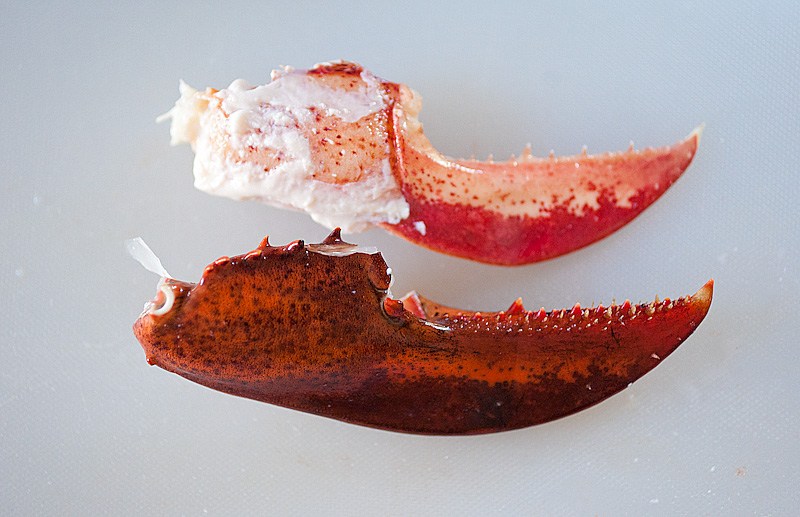
I took my tamarillos from the freezer and let them thaw (mostly), then pureed them in the blender. The recipe indicates that I should have ‘tamarillo juice’ at this point, but I ended up with a very thick, extremely-aerated tamarillo paste of sorts. I’m not sure if this was a result of the freezing process, but it was very stiff, almost like a meringue.
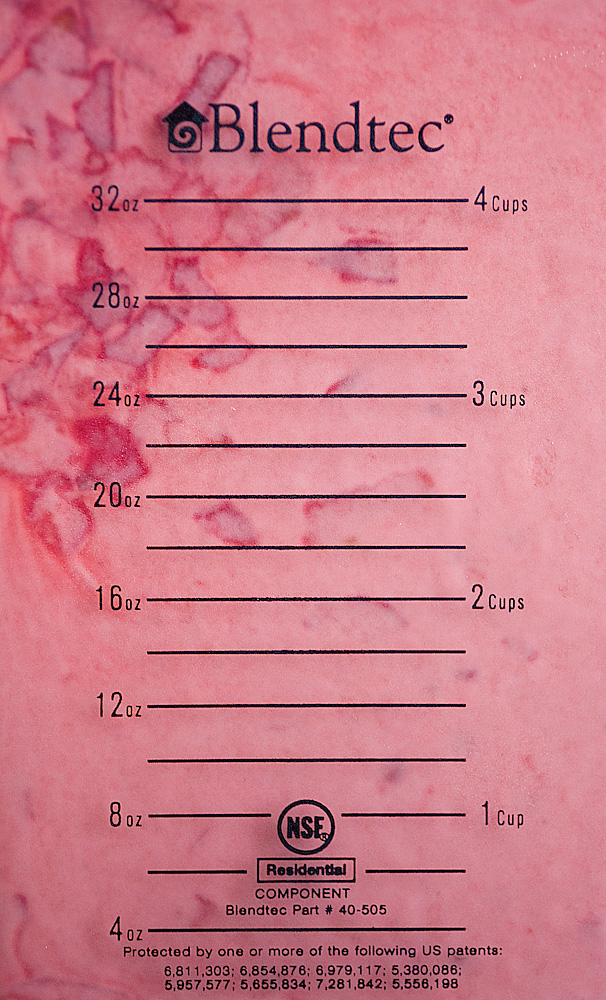
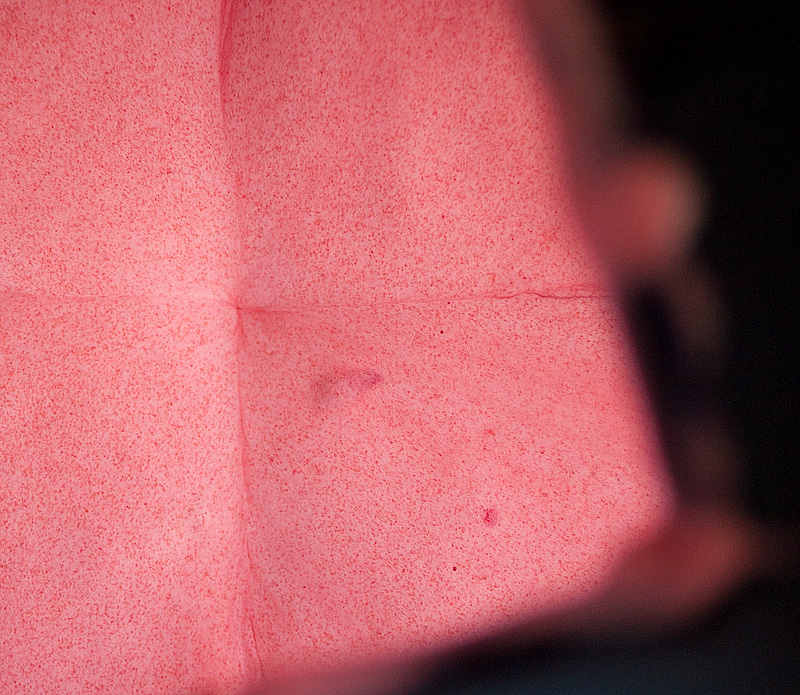
I passed the puree through a tamis to separate out the seeds and skins…
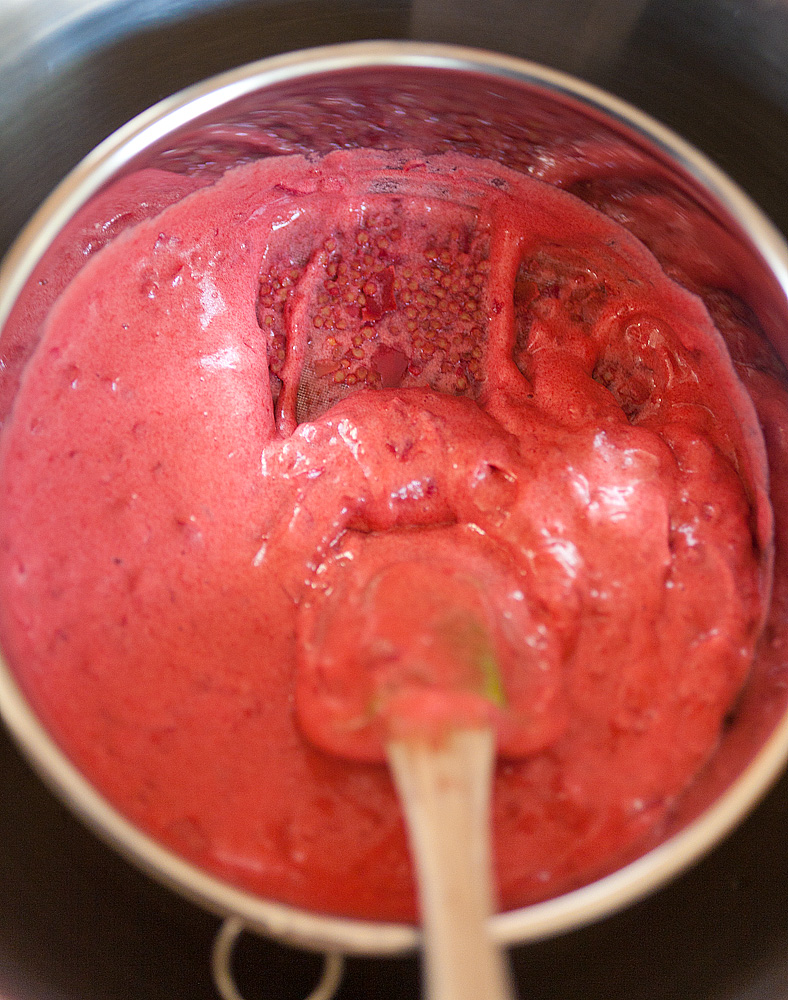
…and ended up with something that was very fluffy and puddinglike in consistency. This gave me pause, because from here I was meant to cook this with agar, then puree it in a blender to, well, a pudding-like consistency. Did I really need to continue processing this if it already had the consistency I wanted?
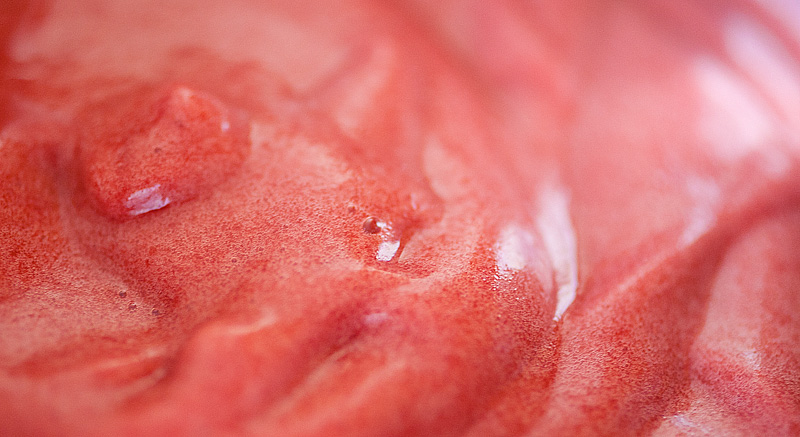
I decided to hedge my bets, and split the batch in two. One half went into a squeeze bottle; I wanted to see if it held its consistency or if it collapsed. I brought the other half to a boil and mixed in sugar, salt, and agar. As it heated, the air bubbles started to collapse and the mixture took on a more liquid consistency, which made it easier to mix in the agar. I let this set, then blended it. The puree was a little chunky, which is what I usually get when I’ve used too much agar. But the taste, to me, seemed less interesting. Several of the more subtle notes had fallen out with the high heat application, and I think I liked the raw puree taste better. Or, at least to me, it tasted more pure and less overworked. I wonder if I stumbled onto something useful by accident here?
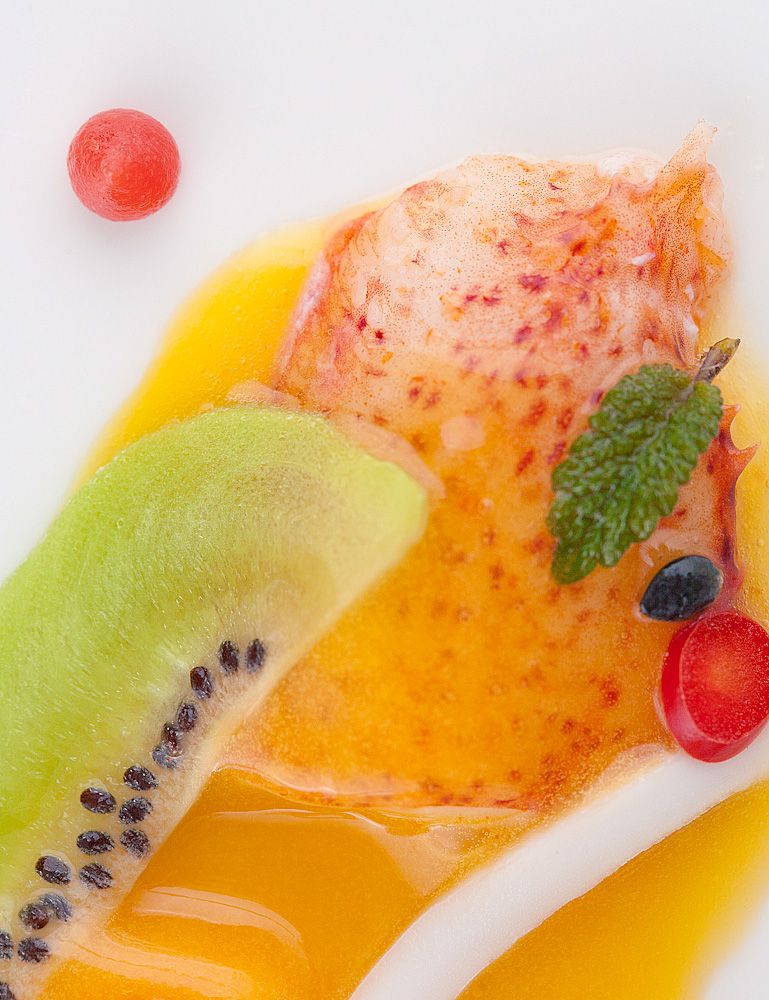
The next step was to make ‘passion fruit sheets’. I did this once before a few years back with raspberries and it worked beautifully. It’s a really neat trick: basically you make something that at room temperature is jamlike in consistency, but when cooled it gels. You freeze this gel, cut it into strips, and lay the strips over your ingredients. As the sheet warms, it drapes over the ingredients and ultimately turns back into the original jammy consistency. It looks as though you’ve somehow spooned this incredibly precise ribbon of sauce over everything.
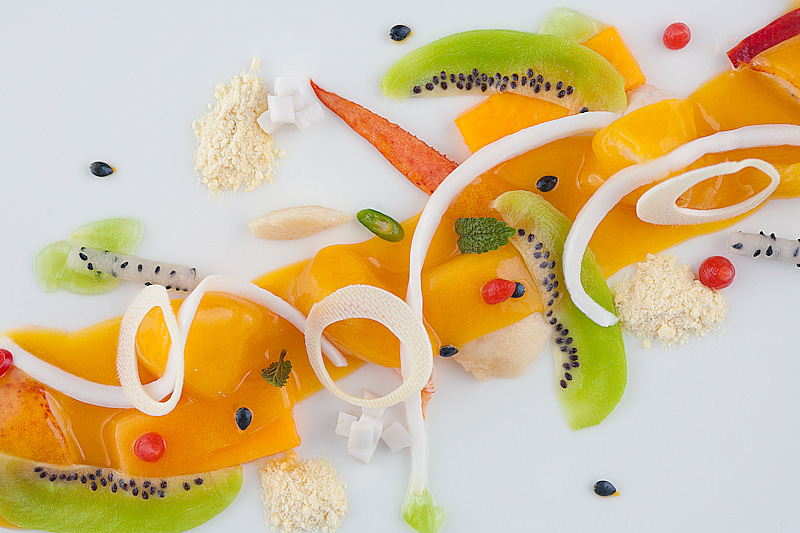
This recipe mentions I’m to start with 40 passion fruits, which at $2.59 a pop at Berkeley Bowl seemed a little excessively expensive to me, not to mention Berkeley Bowl never seems to carry more than just a dozen or so at a time. Rather than go that route, I ordered some passion fruit puree:
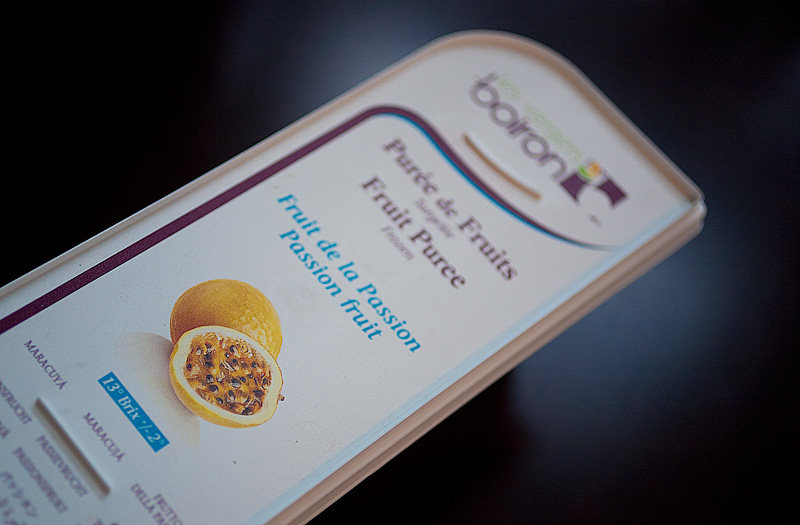
The puree is meant to be heated with gelatin, then ‘spread’ on a sheet of acetate and frozen. I use the annoying quotes because even with the addition of gelatin, my mixture stayed very liquid. I realized the ratio of gelatin specified would never form a gel (usually one needs 1 sheet of gelatin to gel 100g of liquid, and this recipe uses 6 sheets to 800g puree), so I needed to do some debugging. The raspberry recipe used the same proportion of gelatin, but started with whole raspberries, which when heated form something way thicker than just liquid raspberry juice. I figured this was from pectin, and because I was using a processed puree, I had no idea how much (if any) pectin was even in this mixture I was working with.
So, I started doing some experimenting. I have three types of pectin, and only the most basic understanding of their differences. Arbitrarily, I grabbed LM pectin, which the Texture handbook tells me gels in the presence of calcium. I have some Calcium Ascorbate (buffered vitamin C) that I figured might work for this, so I just started adding it and the pectin and whisking to see what would happen. The mixture thickened slightly but never really took on the jammy, saucelike consistency I wanted. I tried adding more gelatin, but that only ended up giving me something too ‘gelatiny’…more like a fruit- rollup than a sauce. If the mixture is too gel-like, it’s obvious that I’ve just laid a sheet of gel over everything on the plate and it’s not nearly as magical. I felt confident that the pectin was the right direction to be looking, I just needed to figure out how to make it work properly.
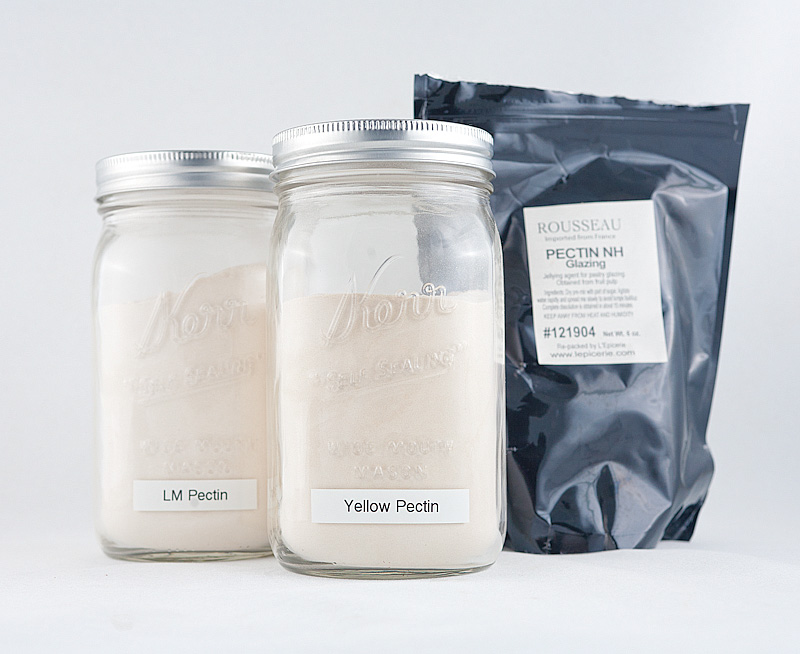
I realized that working with LM (and NH) pectins, which both involve the need for calcium, meant trying to solve for two variables at once. So I switched to HM pectin (or yellow pectin, it’s sometimes called). This gels in the presence of sugar, which was way easier for me to estimate. After a few more tries, I ended up with something that at room temperature was the consistency of smooth jam and when cooled set into a gel.
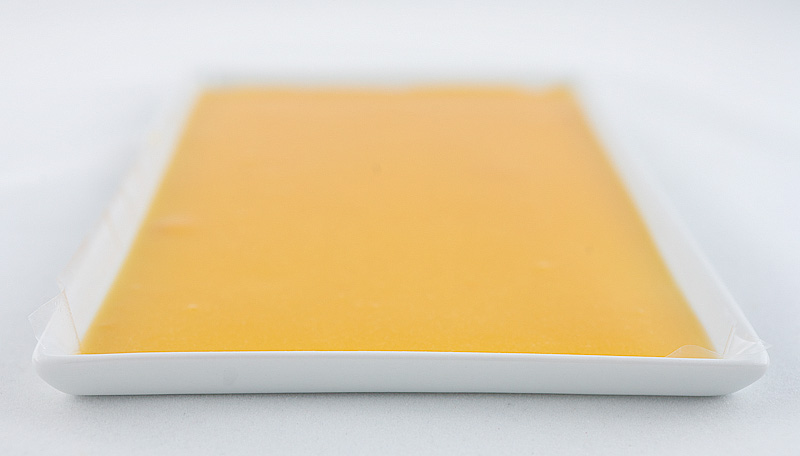
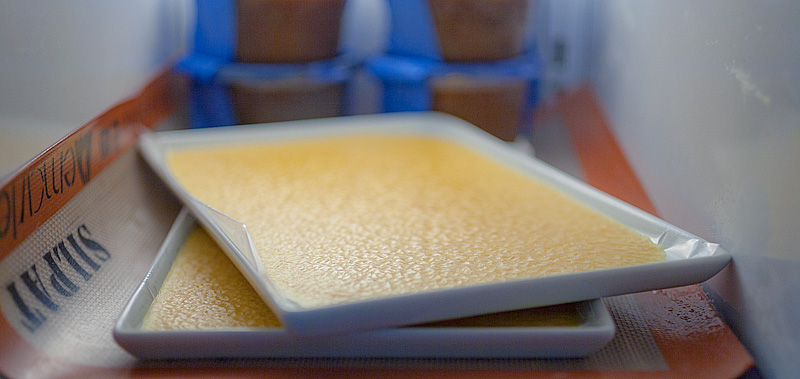
I took one crappy photo of a test I kept doing throughout this process…I’d freeze a bit of the mixture and then drape the frozen sheet over a spoon to see how it behaved when it warmed. You can see here a pretty obvious difference: on the left is the pectin mixture, and on the right is a mixture that had too much gelatin in it. You can kinda picture how each of these would feel in your mouth when eaten, or how they’d behave when poked at with a spoon.
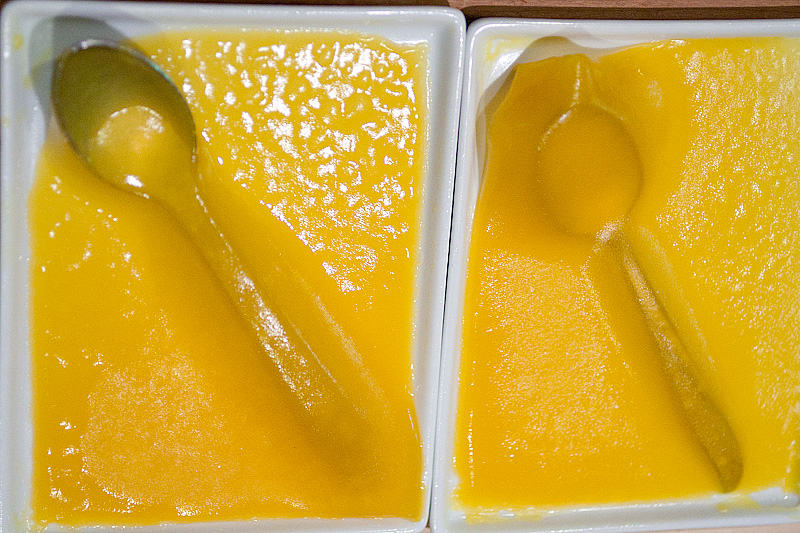
Finally satisfied with my passionfruit mixture, I settled into the super-fun part: cutting a bunch of shit up. I started with a coconut, which–not matter how many times I do it–always makes me feel like a total Survivorman badass. It’s so super-fun! Here’s how do to it: we start with a young coconut, which oftentimes is wrapped tightly in plastic and has much of the near-white fibrous coconut husk still attached. This husk can be shaved off easily with a knife…I like to use my cleaver for it. Just let the contour of the hard inner coconut guide the knife. You don’t want to cut into the hard coconut yet…you just want to give him a little shave to clean him up.
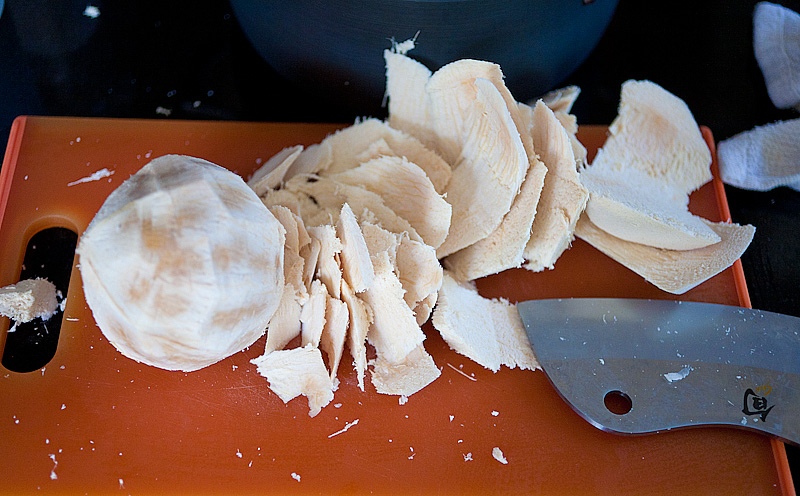
You’ll eventually be able to see three seams running down the length of the coconut. Using the back of your cleaver, tap along the length of each one from one pole of the nut to the other. Be firm but don’t go nuts…you want to cause stress fractures, not bash a giant hole in it. Eventually the tapping causes natural tension in the coconut to pop the shell open. Have a bowl under your hands as you do this; as soon as it pops open, the fluid inside will stream out. Then you can use the cleaver to wedge open the coconut, and use a spoon to scoop out the flesh.
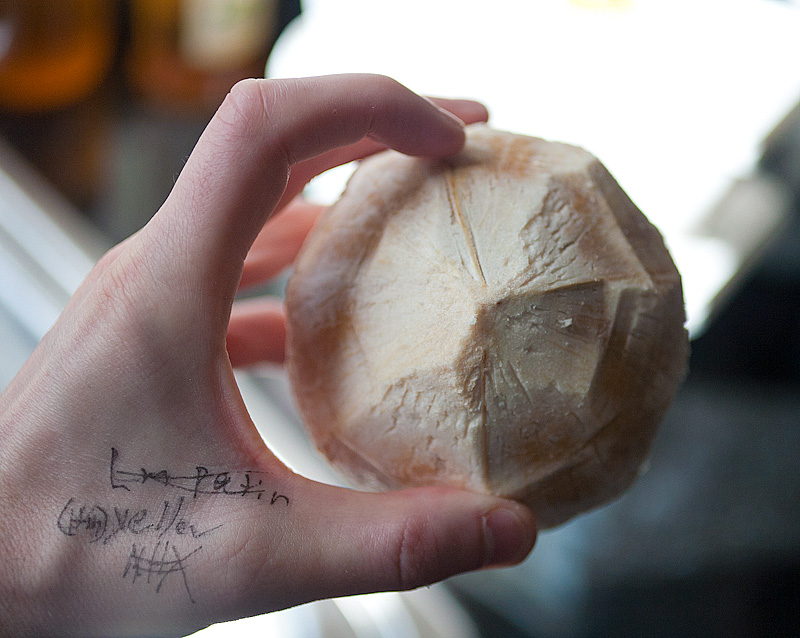
I diced some of the coconut flesh into small cubes, and cut the rest into thin ribbons.
Then, it was on to the orgy of cutting up a bunch of tropical fruits. The book doesn’t specify what kind of papaya to use, and since I’d never eaten papaya before, I bought a few varieties. This one is apparently the most common variety; green-to-yellow when ripe, with large black interior seeds.
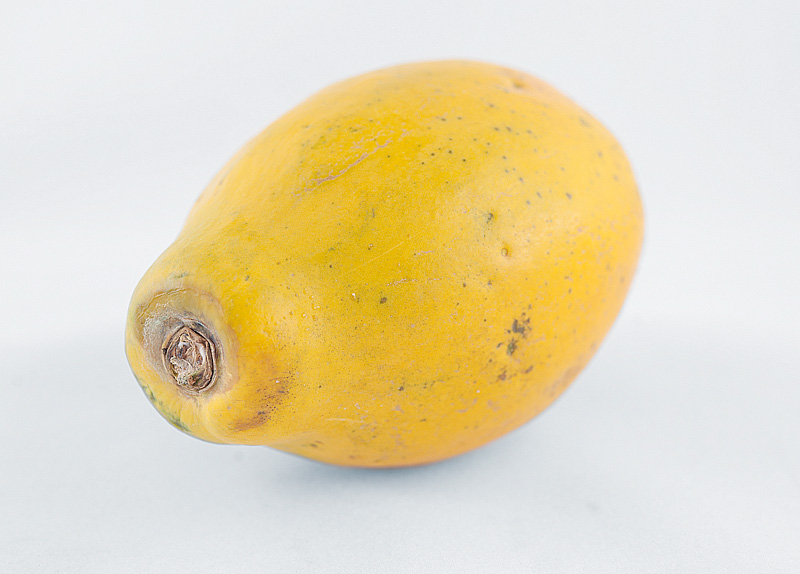
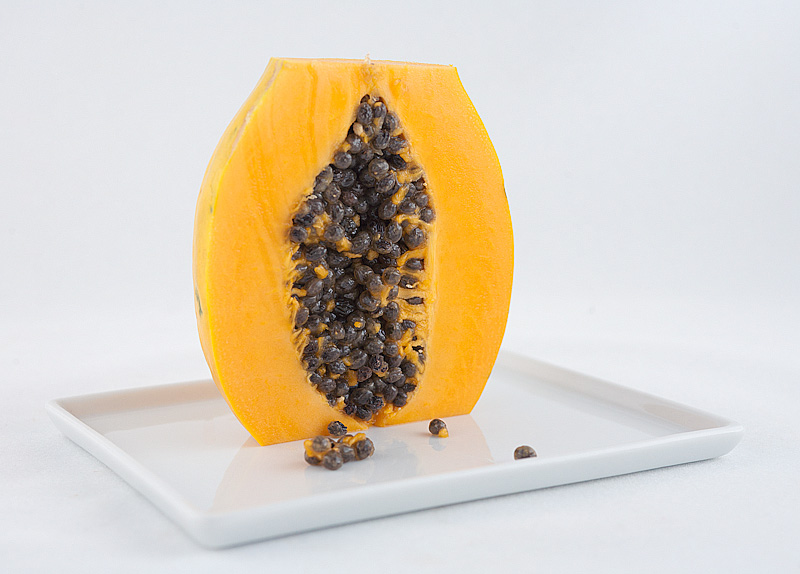
I also found a “Thai cooking papaya”, which was larger and firmer with interesting white seeds, but the flesh was very firm and not really suited to eating raw.
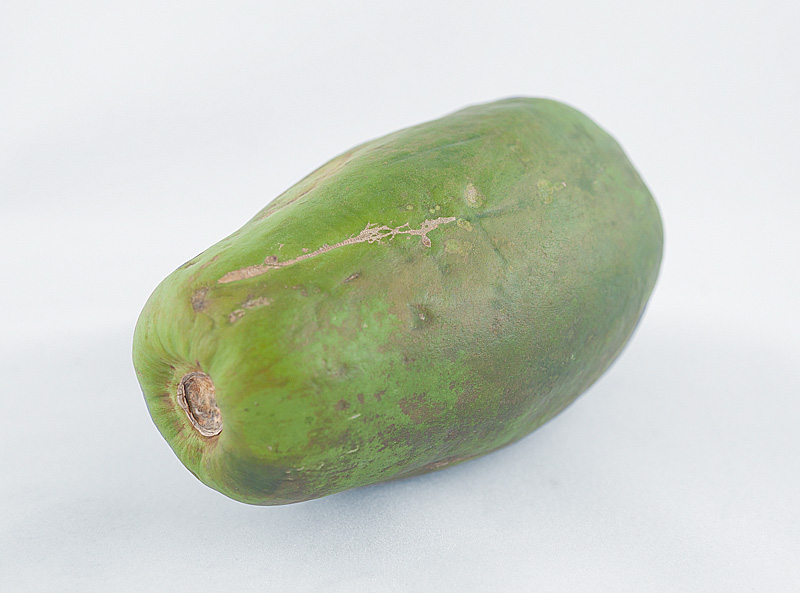
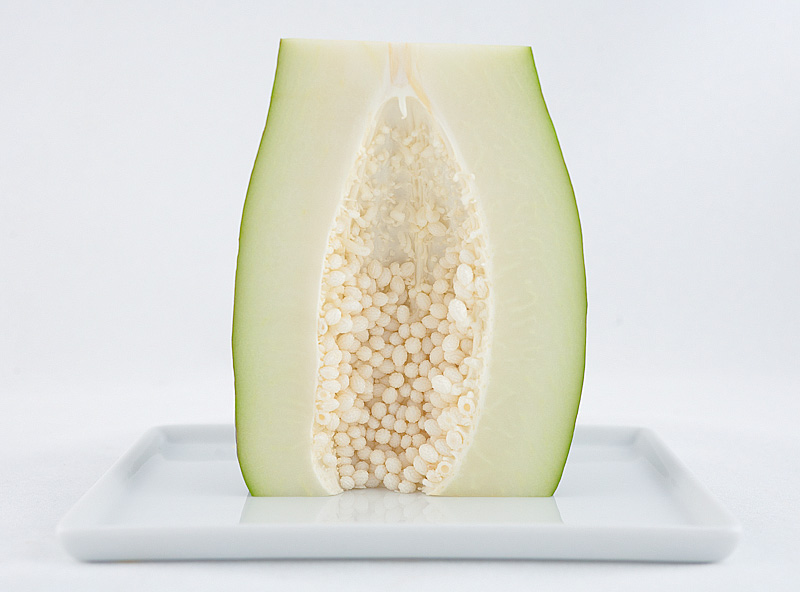
These are Chirimoya; the interior flesh is very soft and can be eaten with a spoon. There’s a slightly odd funky smell just under the super-sweet smell of the fruit when ripe, but the taste is delicious.
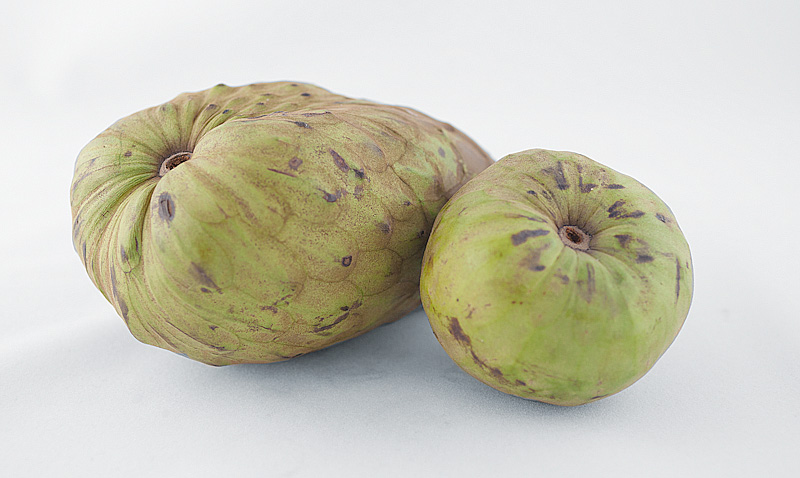
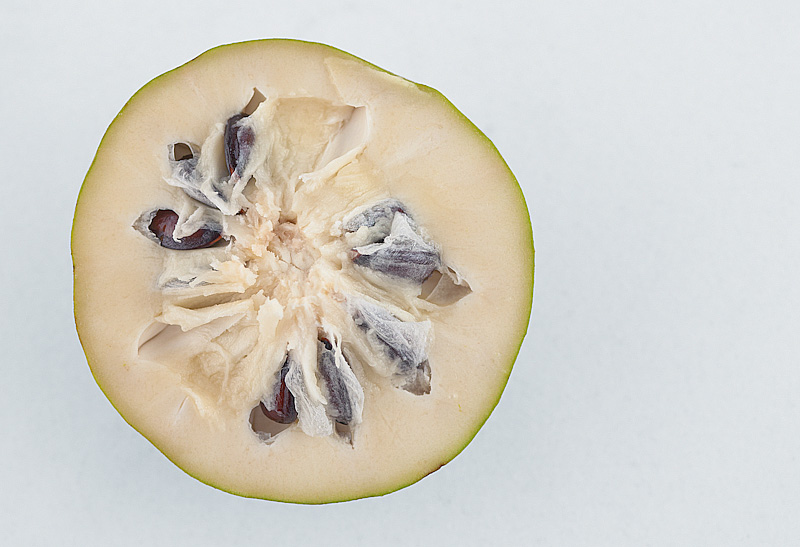
This awesome thing is a Dragonfruit; the exterior of this particular one is a little beaten up, but it’s still ripe and the interior is in good shape (and pretty wild). The flavor of this is very mild, but the texture is neat; it’s sort of like a mealy pear mixed with sesame seeds.
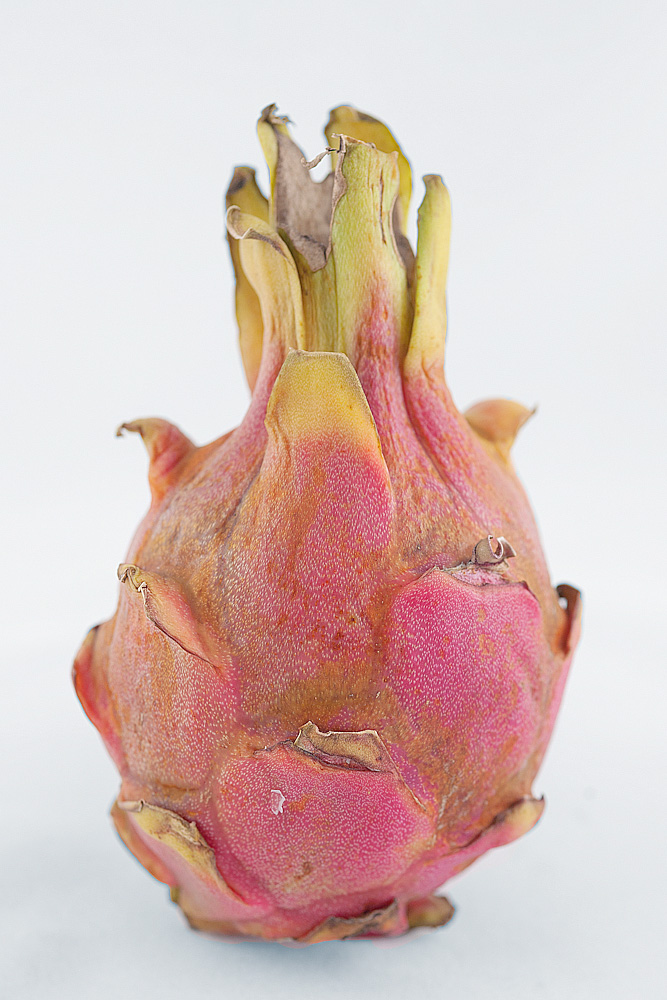
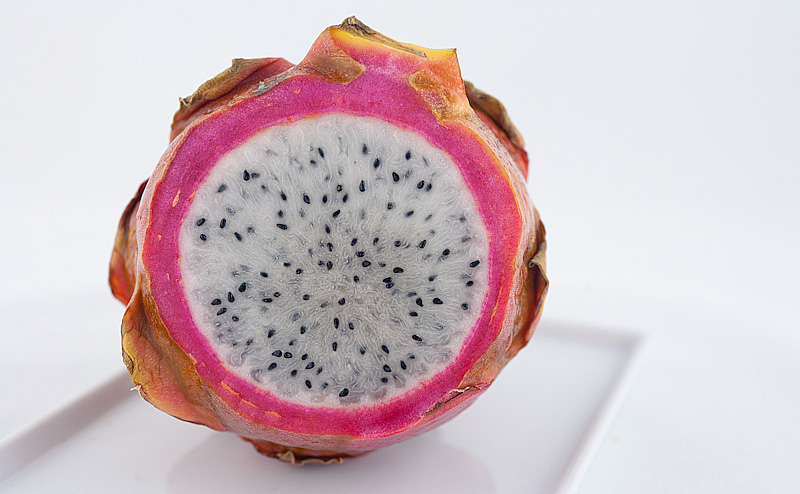
This is a passionfruit; Sarah and I became addicted to these in New Zealand, where there was always a big bowl of them at work in the morning. They’re very tart and sweet, extremely candy-like. They look a little gross inside the first time you see one, but the flavor quickly overshadows that. The seeds are crispy, almost like a potato chip or like they’ve been deep-fried or something. Cut one open and just scoop out the interior with a spoon and eat it all. For this dish I needed to separate the pulp from the seeds, which would be used individually during plating.
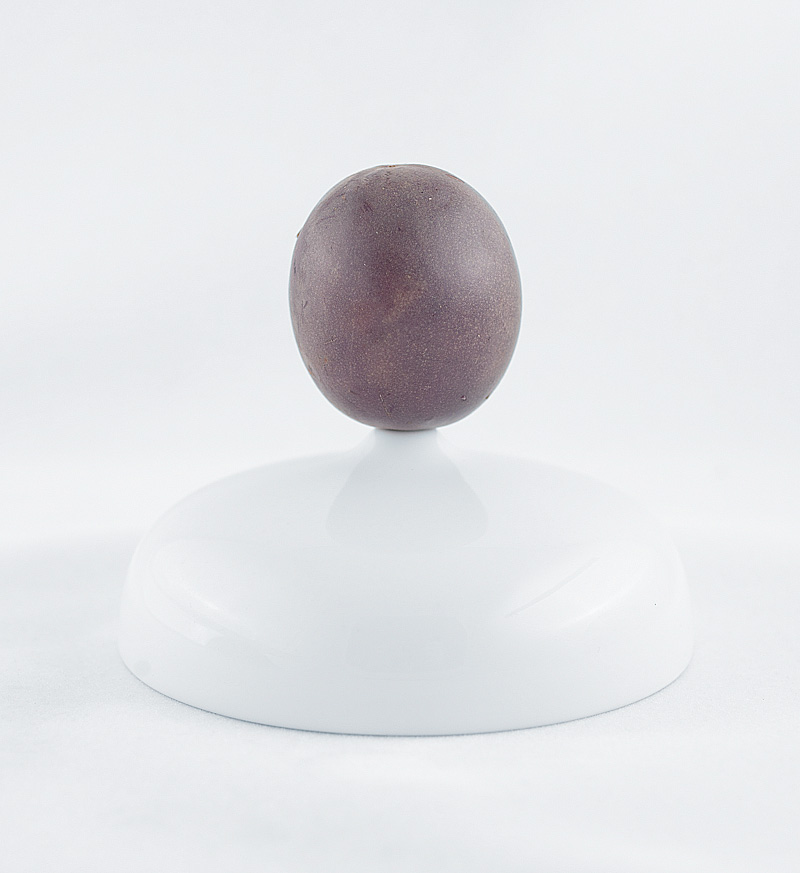
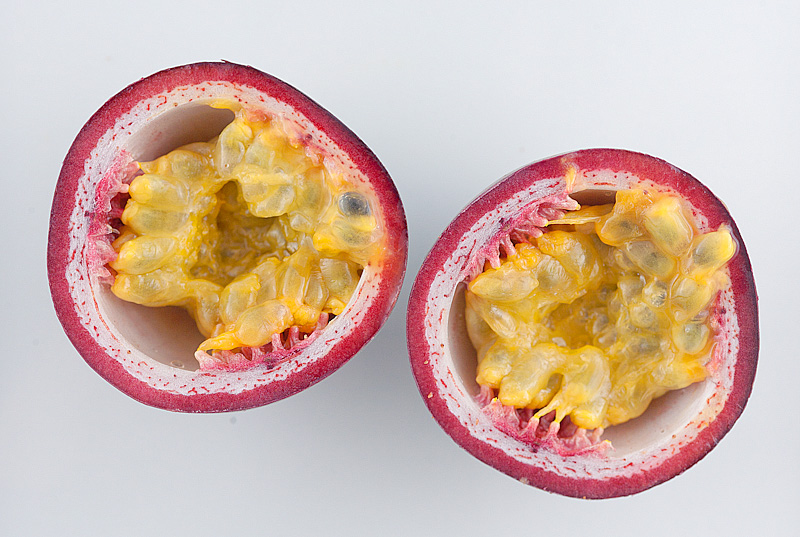
To cut up the kiwifruit, I peeled them with a vegetable peeler, then used the natural (and very subtle) divisions in the fruit to remove very thin slivers containing single layers of seeds. You can see the striations of the fruit most-clearly at the poles.
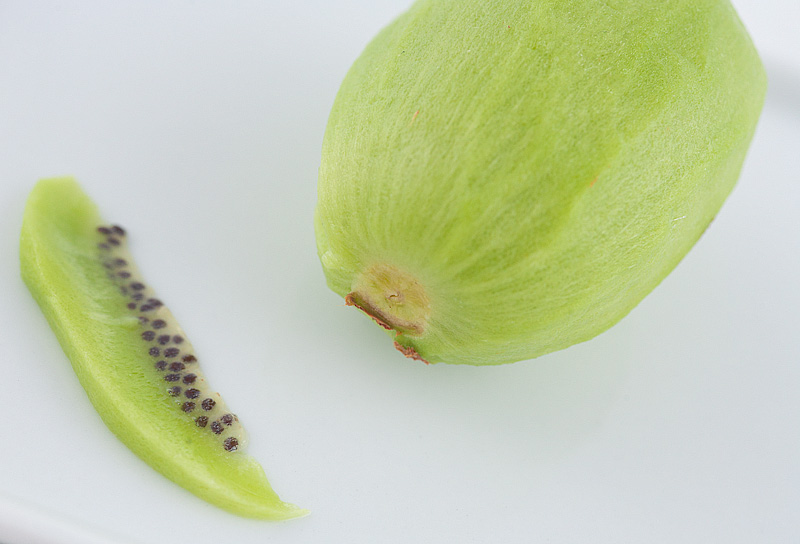
This is my first time working with hearts of palm, but several upcoming dishes use it so I was excited to try it out here. I know that the most common way of finding hearts of palm is canned, but that’s been cooked and–from what I’ve read–isn’t the same as working with fresh. Berkeley Bowl has these in the produce section, which I imagine is sort of in-between buying fresh and canned. There’s some liquid in the package, but it doesn’t seem like it’s cooked. The hearts are crunchy and raw-tasting; not quite as crunchy as celery, more like a water chestnut. The flavor is refreshing and light and familiar to me, but articulating why eludes me. While these guys are perfectly fine in a pinch, I really want to try to source some fresh heart of palm in the future, just to compare.
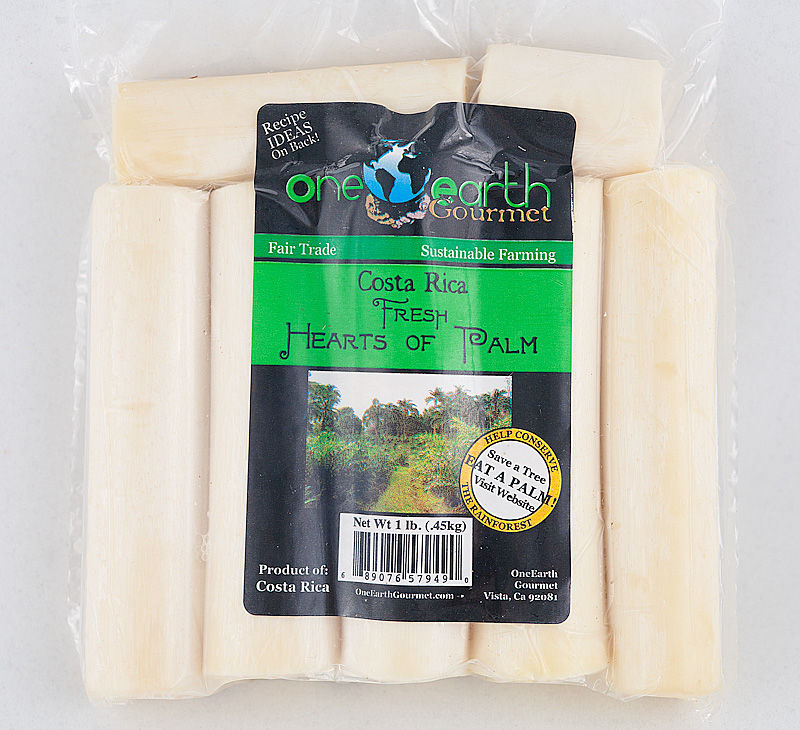
When I cut into the Mamey sapote, it looked quite a bit different from the white one. It also wasn’t ripe enough to eat, so after all that I ended up not being able to use it. But the smell of this thing is incredible. It smells like nutmeg and sweet potato and allspice; it’s the craziest-smelling fruit I’ve ever, um, smelled. I had bought two, so even though I had to throw this one out after cutting into it, I waited for the other to ripen, which it did a few days later. The interior had turned a deep red-orange, similar to a yam, and the scent had intensified. It’s sweet, but not cloyingly-so relative to the other tropical fruits here. The flesh is soft like an avocado and I could eat it with a spoon. If you can find one, definitely try it!
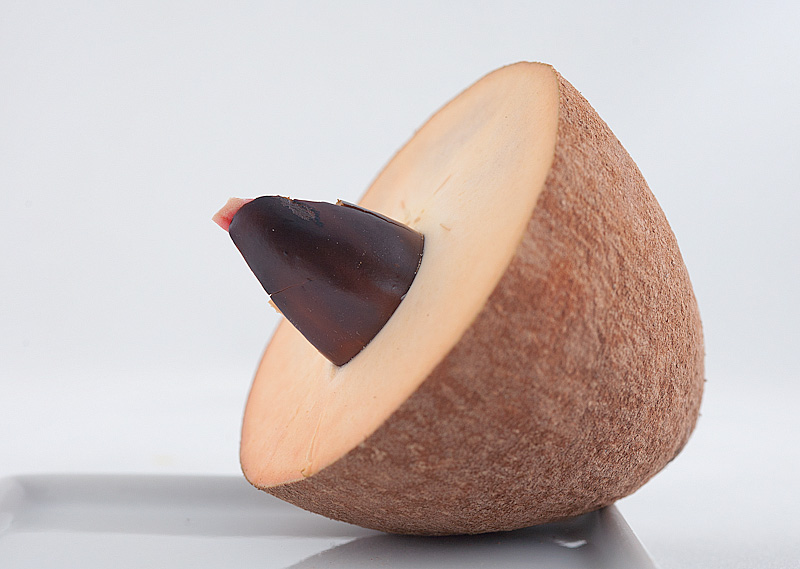
And finally, the “That Shit Cray” award goes to this guy: a Kiwano–or Horned Melon–from New Zealand:
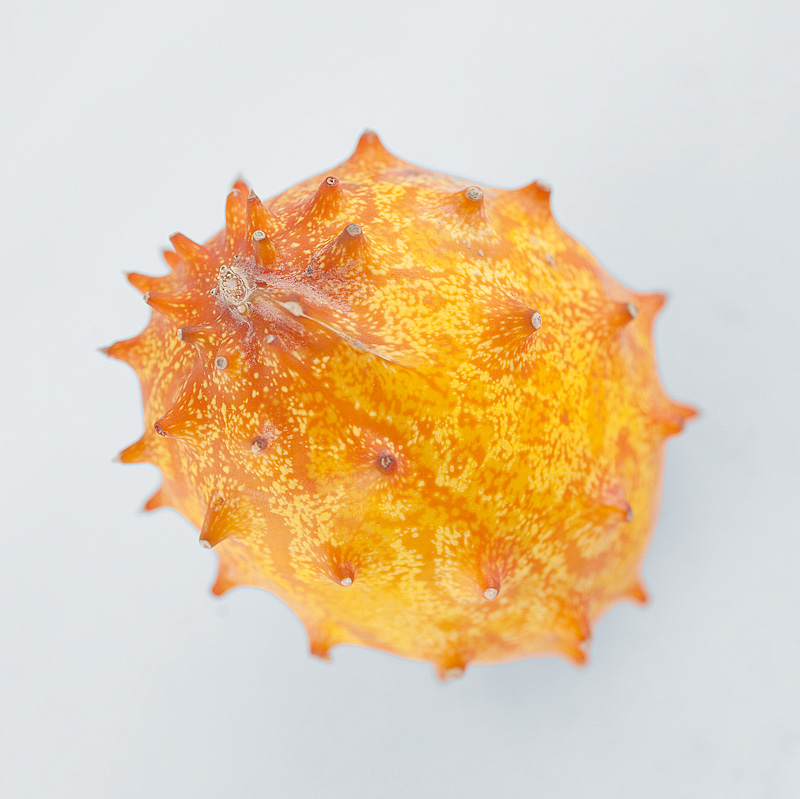
In a million years I would never have guessed from the outside what the inside of this thing looked like:
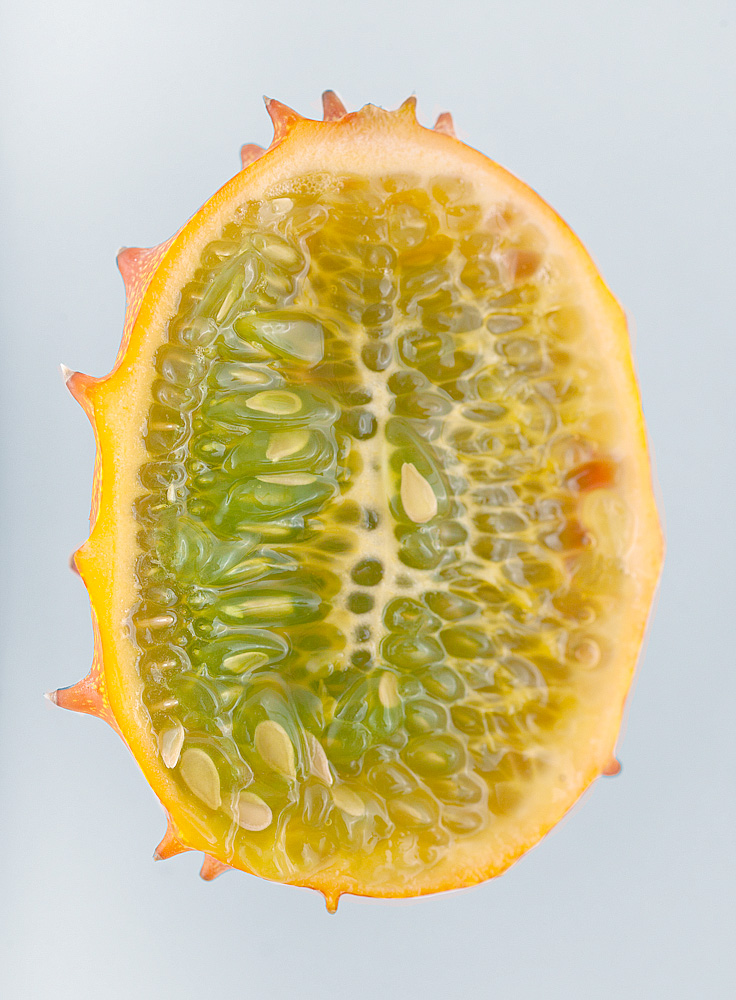
The interior seeds are similar to fresh pumpkin seeds, only much smaller. Each seed is encased in a gelatinous little pouch, which is filled with juice. I was so surprised by it that it took me a few minutes to even think of what I might do with it. I could probably do some interesting and fun things with the juice itself (maybe make Kiwano Puffs like the Cinnamon Puffs from a while back, or a sorbet), but everything else in this dish doesn’t stray too far from its original form, so I wanted to process it as minimally as I could. So I cut small holes in a few of the seed packets and removed the seeds, leaving a little gelatinous ‘envelope’ behind. I did this for maybe 40 or so of them, then put the rest of the seed packets into a blender and blended them on very low speed just to break open the packets and release the juice. This was strained, and I put my reserved intact seed packets into the juice to let them absorb it until time to plate.
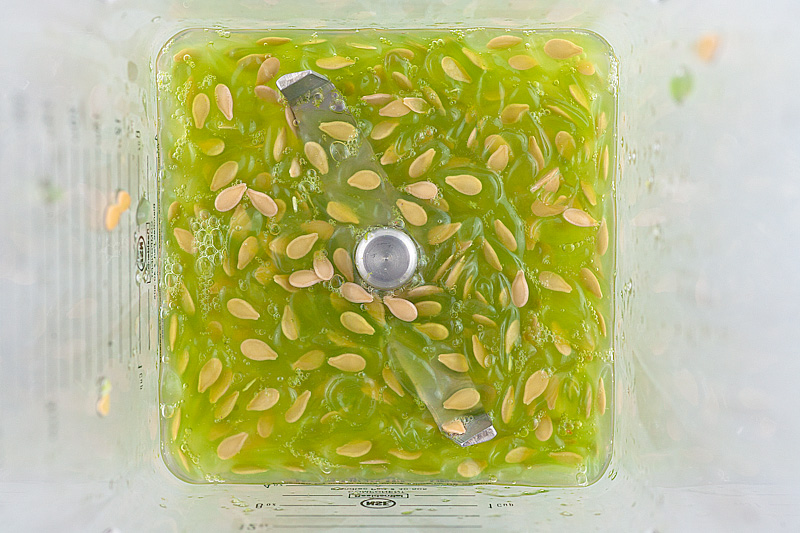

Here’s mise en place for most of the tropical fruits…
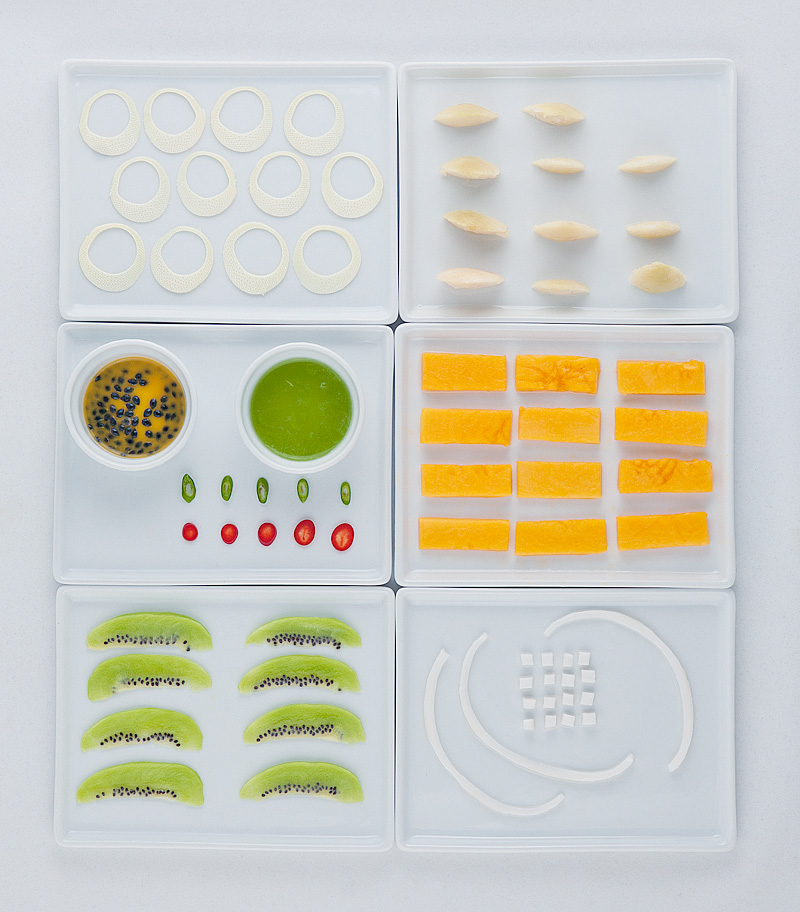
…then “put everything on a plate and try to make it look pretty”.
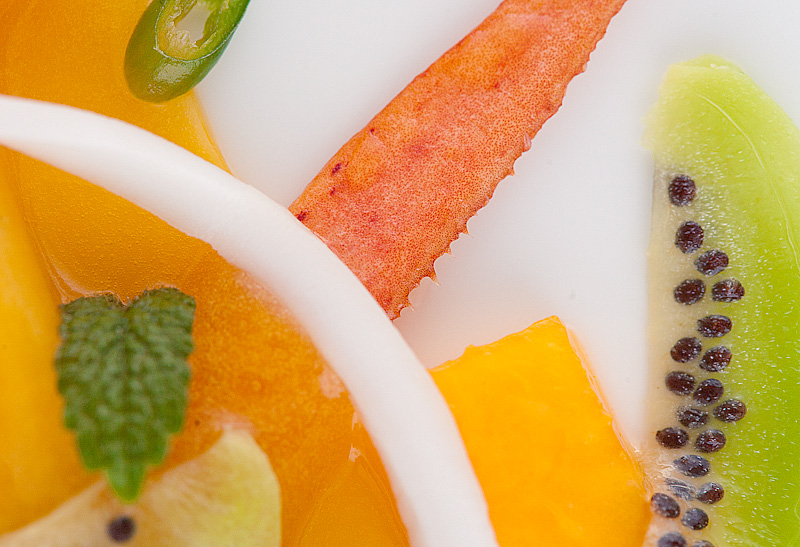

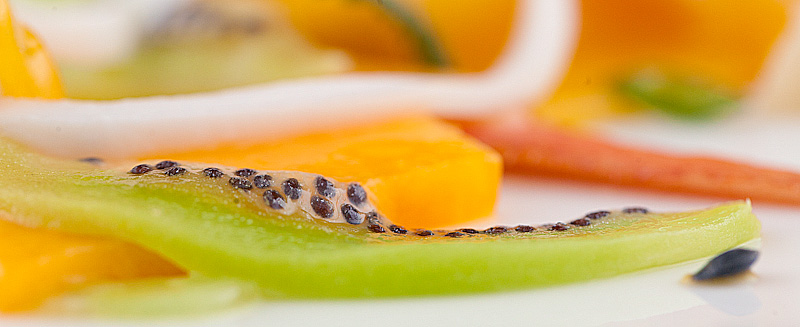
The powder here is freeze-dried pineapple that I crushed in my mortar and pestle.
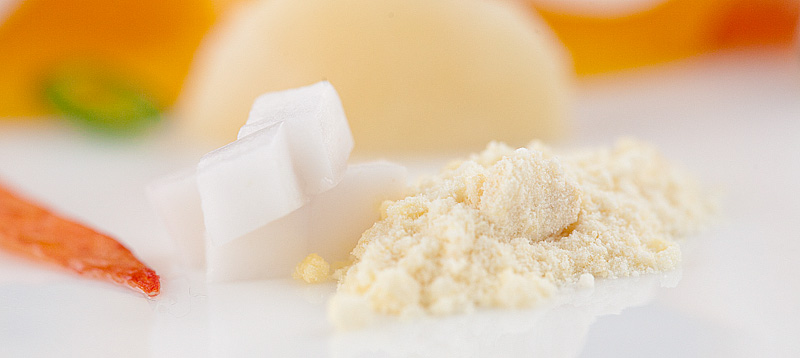
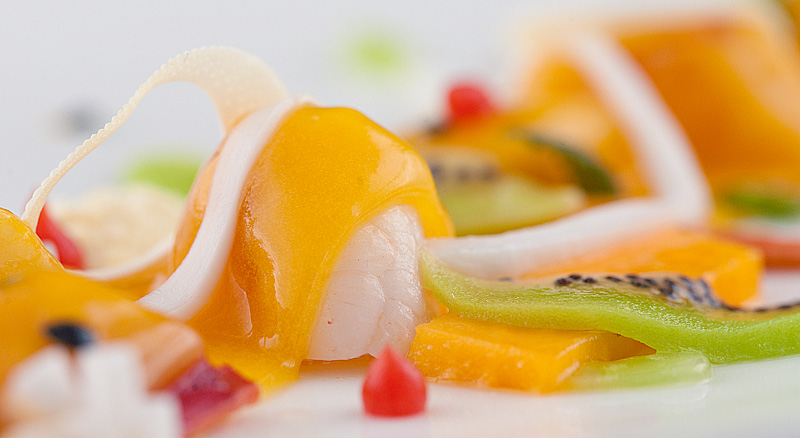
To play with shapes, I cut the dragonfruit into 1″-thick discs, then used a plastic drinking straw to poke out long thing cylinders. I plated several of the kiwano seed packets nearby.
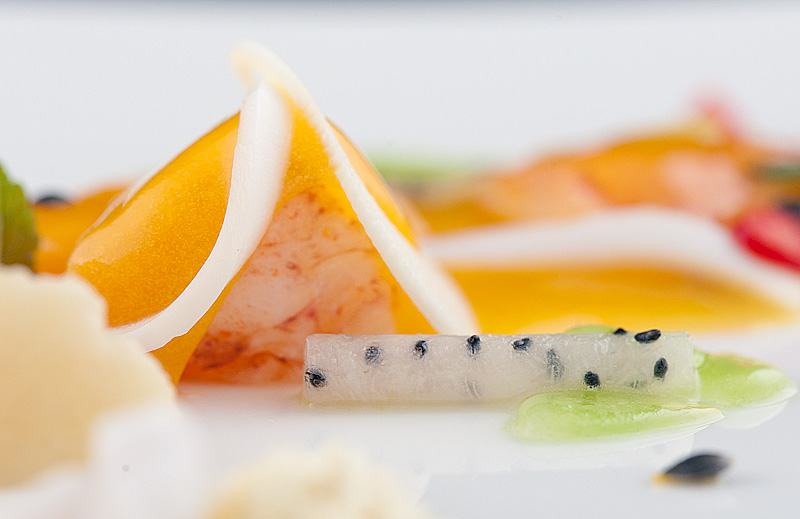
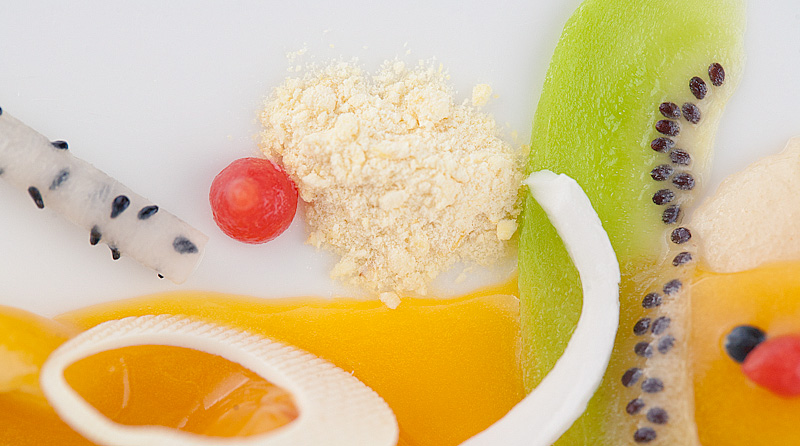
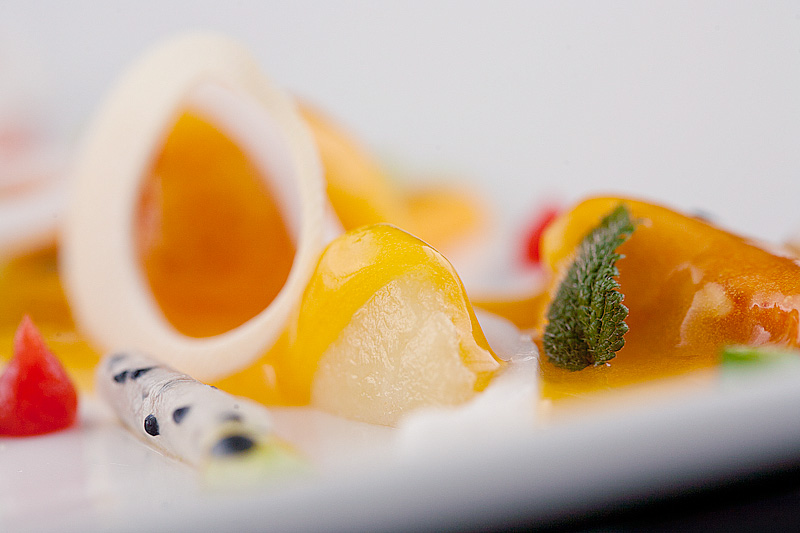
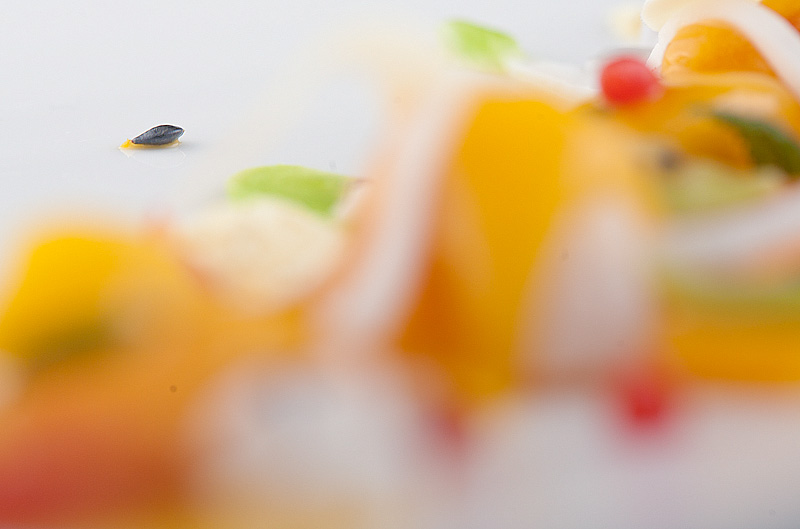
First off, that is a really beautiful plate.
If you aren’t completely traumatized by killing your first lobster, as a New Englander I do have some tips for more humane killing of crustaceans. They do have a more primitive neural system (although I don’t know how this affects their sense of pain) but this, combined with their sensitivity to cold, means that lobsters can be easily anesthetized in the presence of extreme cold. If you put them in the freezer for a short period of time (you don’t want to freeze the meat) they fall into a kind of catatonic state. You can actually check their status by waving a hand in front of their face – an awake lobster will wave it’s claws back at you, a sleeping one will not. Once you have put them to sleep, it’s don’t flail disturbingly in hot water.
This trick also works with other crustaceans, and amusingly, with cockroaches.
This will be such handy information for the upcoming recipe I’m starting: “Cockroach, Crumbs From Under My Oven, Darkness, Truffle”!
Though, seriously, that’s rad! Thank you! And now I kinda want to get another lobster and try this. I wonder how it affects cooking times.
Allen, what a wild post! I’m going to have to keep my eye out for some of these fruits, though it seems pretty unlikely that I’ll ever run into them in my neighbourhood.
I’m so glad that you liked Consider the Lobster. I think that the eponymous essay is my favourite of the collection. DFW’s bewilderment over what to think about lobsters gets it right, I think, in the sense that the question of animals, whether to eat them or not, is a hard subject matter, and he’s sensitive to that.
Out of curiosity, where did you get your passion fruit puree from? I’m actually going to need some this week for a Milk Bar cake. I’ll probably just track down some Goya stuff locally, but I debated for a while about ordering some fancier French stuff. I was only deterred because the vendor recommended buying at least 4 1-kilo tubs of fruit puree to make sure that they all stayed frozen during shipment. I didn’t really feel like spending $80 on frozen fruit plus overnight shipping.
Hi Katie!
Crap, I’m so sorry for my delay in responding; I got my puree from Marky’s Caviar, which I think is in NYC. I chose it only because it didn’t have a 4-kilo minimum shipment, and the puree is a little cheaper. I ordered 2 1-kg tubs and they showed up the next day totally fine. I can’t bring myself to buy that Napa Perfect Puree stuff; it’s way more expensive and they enforce that 4kg minimum, which I don’t think is terribly justifiable.
The brand Marky’s sells is Boiron. I haven’t tried ordering similar stuff from L’Epicierie yet, again just because of the shipping charges. Both of the Boiron purees I’ve ordered from Marky’s have seemed totally fine to me.
Cheers!
–a
Hi Allen,
Your website is amazing and all you have accomplished to such perfection. I have gone through almost every recipe of the book myself. A dish that I have not done yet is the Sassafras Encapsulated in Mandarin Ice. As I am going over the recipe in the book, there are some things that make no sense and maybe you can help me clear this up. It tells you to cut strips of acetate that are 9.5″ long by 1 1/2″ wide. Why this long if the diameter of the cylinder should only be 1/2″? The picture of the cylinder in the book seem taller than 1.5″? I would truly appreciate any advice. Thanks!
Hi Marcel! Thanks very much for the lovely compliment; that’s very generous of you and I very much appreciate it!
As for the cylinder dimensions; I can only really guess, but for me, the length of the acetate strips leads them to double up quite a bit as you form the tube, the tension of which helps the tube keep its shape. You might get away with shorter strips, but if they’re only the exact circumference of the final tube the tube itself will have a little crease or lopsidedness to it from the way the acetate’s tension works. So, yeah, I just wrapped them around and around themselves…when you try it a couple of times it’ll make sense.
As for the length, I too found the recipe’s instructions to result in tubes that look quite a bit shorter than the photos in the book. I don’t think there’s harm in making the width of the strips longer at all; had I not already cut up all my acetate I would have tried to make a few strips that were wider myself. Your guess is as good as mine re: the visual discrepancy there though!
Allen, no worries. I’d already planned to find puree locally, though I will look into your source the next time I want more. I went to a Latin market on the other side of town and spent $6 on about 1 lb of puree. Was your puree good enough to eat on its own? I’ve never eaten fresh passion fruit, so I didn’t know what to expect. The puree smelled really tropical–very similar to mangoes–but I wasn’t terribly fond of it on its own. It was more than fine for making curd, though. The Milk Bar passion fruit curd may just be my favourite thing out of the book yet. If Sarah hasn’t made it yet, you should encourage her.
Thank you!! I will give it a shot tonight. I have the rest of the components done! I´ll let you know how that goes!! I had the opportunity to meet Ferran Adria at a dinner in Costa Rica a month or so ago.. he is an amazing guy. Now that he will have his “foundation” open in the next year or so, you might still be able to enjoy his food. (I read your post on “Next: El Bulli Menu”
Anyhow, thanks again for such an amazing blog, a work of art! I heard of you from a friend that mentions she visits your site quite often and has posted a few questions for you, Norma.
Best of luck to you!!
I nominated your photographs for this beautiful Tumblr.
http://thingsorganizedneatly.tumblr.com/
They’ve been featured! I hope you don’t mind and I hope you realise that your photos are art in their own right, let alone that you’re talented enough to make this beautiful food.
A long term fan!
Hi Amelia! Wow, this is so super-cool of you! Thank you so very much, both for the very thoughtful compliment and the thought to posit some of these photos to Things Organized Neatly (which I LOVE)! So neato!